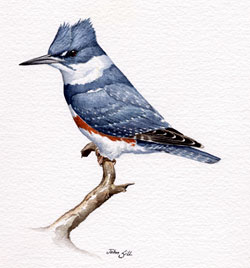Breeding Bird Atlases (BBA)
Find a Bird - BBA1
Breeding Bird Atlas 1 Species Accounts
Belted Kingfisher
Ceryle alcyon
Egg Dates
May 11 to June 6
Number of Broods
one; may re-lay if first attempt fails.

The Belted Kingfisher is an uncommon but widespread and familiar species in Massachusetts. It is most prevalent at lower elevations near salt- or freshwater where there are suitable banks or cliffs for nest burrows. It is decidedly less common in the higher elevations of the central and western portions of the state and is notably scarce on Nantucket due to a lack of nest sites.
Hovering kingfishers, poised over the water with spread tail in a nearly vertical position, are a familiar sight. In normal flight, a series of five to six rapid wing beats is followed by a long glide. Kingfishers feed by plunge diving, plummeting down into the water from 20 to 40 feet in the air or from a perch when they spot their prey, remaining immersed for only a few seconds. Sometimes they will also dive below water to escape predators. After a plunge, the bird returns to its perch, stuns its prey by slapping it against the branch, flips it in the air, catches it headfirst, and then swallows it. Fish are the main food, but crayfish, crabs, insects, and tadpoles also are taken. Sometimes a large fish will protrude from the bill until swallowing can be completed after digestion has begun. If disturbed, kingfishers fly to the limits of their territory and then circle back.
The voice of the Belted Kingfisher is a clattering, dry rattle, aptly likened to the sound of a heavy fisherman’s reel. During courtship, the birds produce a mewing sound and also keep up a continual, prolonged version of the rattle call. In this species, it is the female that is more brightly colored, sporting a chestnut band across the breast.
Migrants begin appearing in the interior in March as the ice breaks up. Others arrive in April, and there is still some movement in early May. The habitat is along all types of waterways: lakes, ponds, streams, wooded creeks, rivers, and marine bays and estuaries. The birds adopt favorite perches, near or over the water, to which they return repeatedly. They may roost in evergreens.
Nest sites are burrows near the top of a bank that is relatively free of vegetation. These may be natural bluffs but very often are sand and gravel pits shared with a colony of Bank Swallows. Nests are found rarely in the top of a hollow stump or in a tree cavity, but this has not been documented in Massachusetts. Ten recent nest sites in central Massachusetts were all in gravel banks at a height of 10 to 40 feet (Coyle, Meservey). Two Essex County nests were in sand banks at 7 feet and 20 feet. The latter, in Rowley, was 50 feet from a previous nest hole then being used by Northern Rough-winged Swallows (CNR).
Both sexes excavate the tunnel, which is generally from 3 to 10 feet, sometimes as much as 15 feet, long and which slopes upward to the nest chamber. The latter is often littered with excrement, fish scales, and regurgitated pellets, to which the birds may add a few sticks, leaves, or dry grass. Burrow construction takes from 3 days to three weeks. The male may dig one or two shorter tunnels nearby for roosting. The Belted Kingfisher is highly protective of the nesting area and will attack birds many times its size if the territory is invaded. On smaller inland watercourses, the birds are very territorial, but near the coast several pairs may nest in close proximity. Three pairs were observed to have nest burrows on a small island near Woods Hole (EHF).
The female lays five to eight (rarely more) eggs, which are glossy white and unmarked. Clutch sizes for 3 Massachusetts nests were six eggs (2 nests), seven eggs (1 nest) (DKW). Both adults incubate for 23 to 24 days and feed the young, which are altricial, hatching blind, naked, and helpless. They huddle together for warmth. After a week, pin feathers appear, and in about 18 days the bristly sheaths release the juvenal feathers. At about four weeks of age, the young fledge, looking like pale versions of the adults. At this time, both sexes show some rusty spotting on the pectoral band. The family remains together for a short time until the juveniles can forage on their own. The birds then disperse and are generally encountered as solitary individuals.
In Massachusetts, adults have been recorded feeding nestlings from June 13 to July 1 (CNR, Meservey). Pairs with two to four fledged young were observed from July 3 to July 17 (TC, Meservey). One brood is raised each year, but the birds will generally re-nest if the first attempt fails.
Belted Kingfishers are present in Massachusetts all year but are most common from May to October. Fall migration of residents and transients occurs from late August through November. Wintering birds are generally seen along the coast, but a few individuals usually appear inland, even in the dead of winter if there is open water. The main wintering grounds extend from the southern states through the West Indies and Middle America to northern South America.
Map Legend and Data Summary
Atlas 1 data collected from 1975-1979


Note: uncommon but widespread; distribution limited by availability of suitable nesting banks
Patricia Noyes Fox



